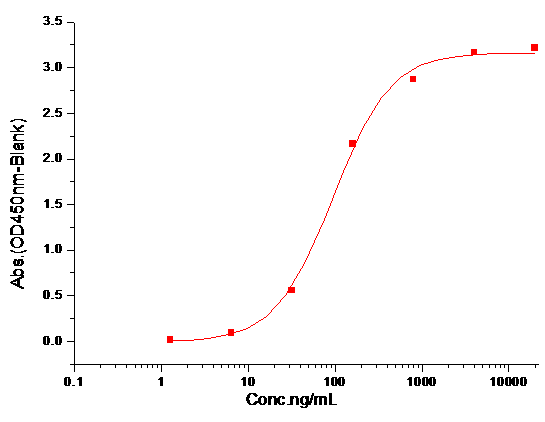Shopping Cart
- Remove All

Your shopping cart is currently empty

| Pack Size | Price | Availability | Quantity |
|---|---|---|---|
| 100 μg | $325 | In Stock | |
| 200 μg | $576 | 7-10 days | |
| 500 μg | $1,220 | 7-10 days |
| Biological Information | 1.Measured by its binding ability in a functional ELISA.
2. Immobilized human VLDLR-His at 10μg/mL (100μL/well) can bind biotinylated human LRPAP1-His , the EC50 of biotinylated human LRPAP1-His is 0.05-0.2 μg/mL.  |
| Description | The very low density lipoprotein receptor, known as VLDLR, is a single-pass type 1 integral membrance protein and a member of the LDL receptor family. This receptor family includes LDL receptor, LRP, megalin, VLDLR and ApoER2, and is characterized by a cluster of cysteine-rich class A repeats, epidermal growth factor (EGF)-like repeats, YWTD repeats and an O-linked sugar sdomain. VLDLR contains 3 EGF-like domains, 8 LDL-receptor class A domains, as well as 6 LDL-receptor class B repeats, and is abundant in heart, skeletal muscle, also ovary and kidney, but not in liver. VLDLR binds VLDL and transports it into cells by endocytosis. In order to be internalized, the receptor-ligand complexes must first cluster into clathrin-coated pits. VLDLR mediates the phosphorylation of mDab1 (mammalian disabled protein) via binding to Reelin, and induces the modulation of Tau phosphorylation. This pathway regulates the migration of neurons along with the radial glial fiber network during brain development. Defects of VLDLR may be the cause of VLDLR-associated cerebellar hypoplasia (VLDLRCH), a syndrome characterized by moderate-to-profound mental retardation, delayed ambulation, and predominantly truncal ataxia. |
| Species | Human |
| Expression System | HEK293 Cells |
| Tag | C-His |
| Accession Number | P98155-1 |
| Synonyms | VLDLRCH,CAMRQ1,CHRMQ1,very low density lipoprotein receptor,CARMQ1 |
| Construction | The Human VLDLR isoform alpha (NP_003374.3) extracellular domain (Met 1-Ser 797) was fused with a polyhistidine tag at the C-terminus. |
| Protein Purity | > 80 % as determined by SDS-PAGE  |
| Molecular Weight | 86 kDa (predicted) |
| Endotoxin | < 1.0 EU/μg of the protein as determined by the LAL method. |
| Formulation | Lyophilized from a solution filtered through a 0.22 μm filter, containing PBS, pH 7.4. Typically, a mixture containing 5% to 8% trehalose, mannitol, and 0.01% Tween 80 is incorporated as a protective agent before lyophilization. |
| Reconstitution | A Certificate of Analysis (CoA) containing reconstitution instructions is included with the products. Please refer to the CoA for detailed information. |
| Stability & Storage | It is recommended to store recombinant proteins at -20°C to -80°C for future use. Lyophilized powders can be stably stored for over 12 months, while liquid products can be stored for 6-12 months at -80°C. For reconstituted protein solutions, the solution can be stored at -20°C to -80°C for at least 3 months. Please avoid multiple freeze-thaw cycles and store products in aliquots. |
| Shipping | In general, Lyophilized powders are shipping with blue ice. |
| Research Background | The very low density lipoprotein receptor, known as VLDLR, is a single-pass type 1 integral membrance protein and a member of the LDL receptor family. This receptor family includes LDL receptor, LRP, megalin, VLDLR and ApoER2, and is characterized by a cluster of cysteine-rich class A repeats, epidermal growth factor (EGF)-like repeats, YWTD repeats and an O-linked sugar sdomain. VLDLR contains 3 EGF-like domains, 8 LDL-receptor class A domains, as well as 6 LDL-receptor class B repeats, and is abundant in heart, skeletal muscle, also ovary and kidney, but not in liver. VLDLR binds VLDL and transports it into cells by endocytosis. In order to be internalized, the receptor-ligand complexes must first cluster into clathrin-coated pits. VLDLR mediates the phosphorylation of mDab1 (mammalian disabled protein) via binding to Reelin, and induces the modulation of Tau phosphorylation. This pathway regulates the migration of neurons along with the radial glial fiber network during brain development. Defects of VLDLR may be the cause of VLDLR-associated cerebellar hypoplasia (VLDLRCH), a syndrome characterized by moderate-to-profound mental retardation, delayed ambulation, and predominantly truncal ataxia. |

Copyright © 2015-2024 TargetMol Chemicals Inc. All Rights Reserved.